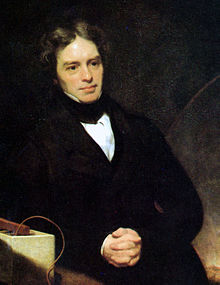Michael Faraday

Michael Faraday [ˈfærədeɪ] (* 22 September 1791 in Newington, Surrey; † 25 August 1867 in Hampton Court Green, Middlesex) was an English naturalist who is considered one of the most important experimental physicists. Faraday's discoveries of "electromagnetic rotation" and electromagnetic induction laid the foundation for the emergence of the electrical industry. His vivid interpretations of the magneto-optical effect and diamagnetism by means of lines of force and fields led to the development of the theory of electromagnetism. By 1820 Faraday was already regarded as Britain's leading chemical analyst. He discovered a number of new hydrocarbons, including benzene and butene, and formulated the basic laws of electrolysis.
Growing up in humble circumstances and trained as a bookbinder, Faraday, who was enthusiastic about natural science, found employment as Humphry Davy's laboratory assistant at the Royal Institution, which became his most important place of work. It was in the Royal Institution's laboratory that he carried out his pioneering electromagnetic experiments, and it was in its lecture theatre that he helped to spread new scientific knowledge with his Christmas lectures. In 1833 Faraday was appointed the first Fuller Professor of Chemistry. Faraday conducted about 30,000 experiments and published 450 scientific articles. He summarized the most important of his publications on electromagnetism in his Experimental Researches in Electricity. His most popular work Chemical History of a Candle was a transcript of one of his Christmas lectures.
On behalf of the British state, Faraday trained the cadets of the Royal Military Academy in Woolwich in chemistry for more than twenty years. He worked for a variety of government agencies and public institutions, such as Trinity House, the British Museum, the Home Office, and the Board of Trade.
Faraday was one of the followers of a small Christian minority, the Sandemanians, in whose religious life he took an active part.

Michael Faraday in an oil painting by Thomas Phillips (1770-1845) from about 1841/42.
Fonts
English first editions
- Chemical Manipulation: Being Instructions to Students in Chemistry on the Methods of Performing Experiments of Demonstration or of Research, with Accuracy and Success. 1st edition, W. Phillips, London 1827, Online.
- Experimental Researches in Electricity. 3 vols, R. Taylor & W. Francis, London 1839-1855, vol. 1, vol. 2, vol. 3.
- Experimental Researches in Chemistry and Physics. R. Taylor & W. Francis, London 1859, Digitalisathttp://vorlage_digitalisat.test/1%3D~GB%3D~IA%3Dexperimentalrese00fararich~MDZ%3D%0A~SZ%3D~double page%3D~LT%3D~PUR%3D.
- A Course of Six Lectures on the Various Forces of Matter, and Their Relations To Each Other. Richard Griffin & Co, London Glasgow 1860, Digitalisathttp://vorlage_digitalisat.test/1%3D~GB%3D~IA%3Dcourseofsixlectu00fararich~MDZ%3D%0A~SZ%3D~double page%3D~LT%3D~PUR%3D.
- A Course of Six Lectures on the Chemical History of a Candle: To Which is Added a Lecture on Platinum. Harper & Brothers, New York 1861, Digitalisathttp://vorlage_digitalisat.test/1%3D~GB%3D~IA%3Dcourseofsixlectu00fara~MDZ%3D%0A~SZ%3D~doublepage%3D~LT%3D~PUR%3D.
German first editions
- Chemical manipulation or the actual practicalities of the safe execution of chemical work and experiments. Publisher of the Landes-Industrie-Comptoir, Weimar 1828, 1832.
- Experimental-Untersuchungen über Elektricität. 3 volumes, translated by Salomon Kalischer, published by Julius Springer, Berlin 1889-1891.
- Natural History of a Candle. Six lectures for the young, translated from the English by Lüdicke, Robert Oppenheim, Berlin 1871.
- The various forces of matter and their relations to each other. Six lectures for the young, translated by H. Schröder, Robert Oppenheim, Berlin [1872].
Current German editions
After the 1889-1891 edition translated from the English by Salomon Kalischer, with an introduction by Friedrich Steinle:
- Experimental Investigations on Electricity. Volume 1, Harri Deutsch Verlag, 2004, ISBN 3-8171-3292-1.
- Experimental Investigations on Electricity. Volume 2, Harri Deutsch Verlag, 2004, ISBN 3-8171-3293-X.
- Experimental Investigations on Electricity. Volume 3, Harri Deutsch Verlag, 2004, ISBN 3-8171-3294-8.
Questions and Answers
Q: Who was Michael Faraday?
A: Michael Faraday was a 19th century scientist who came from humble beginnings as the son of a blacksmith. Despite having only primary school education, he became one of the most influential scientists in history and is credited with discovering many things about electricity and magnetism.
Q: How did Faraday become educated?
A: A local vicar saw his obvious intelligence and paid for him to attend a local school to learn how to read and write. For the most part, however, he was an autodidact who taught himself.
Q: What awards did Faraday receive?
A: Faraday became a Fellow of the Royal Society, and was awarded the Royal, Copley and Rumford medals of the Society.
Q: What discoveries did Faraday make regarding electricity?
A: He discovered many things about the way electricity flowing in a wire can act like a magnet (now called electromagnetism). He also found out a lot about the way electricity can be used with chemicals to make them change (now called electrochemistry). He showed that magnetism is able to affect rays of light, as there is an underlying relationship between the two phenomena.
Q: What inventions did Faraday create?
A: He invented electromagnetic rotary devices which formed the foundation of electric motor technology, making it viable for use in technology today. He also made the first electric motor. As a chemist, he invented an early type of Bunsen burner and popularized terminology such as anode, cathode, electrode and ion.
Q: Where did Albert Einstein keep pictures of Michael Faraday?
A: Albert Einstein kept a photograph of Michael Faraday on his study wall alongside pictures of Isaac Newton and James Clerk Maxwell.
Search within the encyclopedia